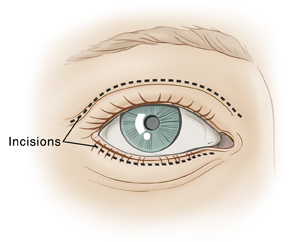Eyelid Surgery (Blepharoplasty)
Eyelid surgery (blepharoplasty) is a type of cosmetic surgery. It's most often done to improve the look of the eyelids by removing excess skin and fat. Loose lids can be tightened. Both the upper and lower eyelids can be treated during the surgery. Or they can be treated separately. Discuss your treatment goals with your surgeon or healthcare provider. They can tell you more about what to expect.

Preparing for surgery
Prepare for the surgery as you have been told. Also:
-
Tell your surgeon about any recent health conditions and all medicines you take. This includes herbs and other supplements. It also includes any blood thinners, such as warfarin, certain anti-inflammatory medicines, clopidogrel, and daily aspirin. You may need to stop taking some or all of them before surgery.
-
Tell your healthcare provider about any eye conditions you have, such as dry eye.
-
Don't smoke before surgery. Smoking reduces the blood flow in the skin and increases the risk for wound healing problems. Nicotine from any source (cigarettes, e-cigarettes, patches, or chewing tobacco) slows healing. Join a stop-smoking program to improve your chances of success. Your healthcare provider may delay your surgery if you are smoking.
-
Follow any directions you are given for not eating or drinking before surgery.
The day of the surgery
The surgery takes about 1 to 2 hours. You will likely go home the same day.
Before the surgery begins
-
You’ll remove any makeup from your eyes. You’ll also remove contact lenses if you wear them.
-
An IV(intravenous) line is put into a vein in your arm or hand. This line supplies fluids and medicines.
-
You’ll be given medicine to keep you free of pain during the surgery. You may have general anesthesia, which puts you into a state like deep sleep during the surgery. (A tube may be inserted into your throat to help you breathe.) Or you may have sedation, which makes you relaxed and sleepy. With sedation, local anesthesia will be injected to numb the areas being worked on. The anesthesia provider will discuss your choices with you.
During the surgery
-
For the upper eyelids, an incision is made along the eyelid crease.
-
For the lower eyelids, an incision is made inside the lower eyelid. Or it's made in the skin just under the lower lash line.
-
With either the upper or lower eyelids, fat may be shaped or removed. Skin may be removed. If muscles are loose, stretched, or torn, they may be tightened or repaired.
-
Incisions are closed with stitches (sutures). In some cases, surgical glue is used.
After the surgery
You’re taken to a recovery room to wake up from the anesthesia. You may feel sleepy and nauseated. If a breathing tube was used during surgery, your throat may be sore at first. If needed, you’ll be given pain medicine to relieve any discomfort. You’ll sit semi-inclined or with your head propped on pillows. You may also have cold packs on your eyes. These measures help reduce bruising and swelling. When you are ready to leave the hospital, an adult family member or friend must drive you.
Recovering at home
Once at home, follow all directions you are given. Your surgeon will tell you when you can return to your normal routine. You may have some bruising and swelling around your eyes and your vision may be blurry. This is normal and should improve within a few weeks. And you may notice your eyes burning or feeling strained during certain activities, such as watching TV, reading a book, or using the computer. While this persists, don't do such activities for too long at a time. Be sure to:
-
Take all medicines exactly as directed. These may include applying eye ointment or using eye drops.
-
Apply an ice pack or cold compress to the eyes as directed, for the first 12 to 24 hours after surgery or as directed.
-
Care for your incisions as directed.
-
Wear protective sunglasses as directed.
-
Wear eye makeup and contact lenses only as directed.
-
Don't swim or put your head under water.
-
Don't lift anything heavy or do strenuous activities. Doing so can cause bleeding.
-
Don't drive until your surgeon says it’s OK. Don't drive while taking medicines that make you drowsy or sleepy.
-
Continue to not use nicotine products.
When to call your healthcare provider
Call your surgeon/healthcare provider right away if you have any of the following:
-
Chest pain or trouble breathing (call 911 or other emergency service)
-
Fever of 100.4° F ( 38°C ) or higher, or as directed by your healthcare provider
-
Increased redness, tearing, or itching of the eyes
-
Changes in vision, such as double vision, blurry vision, or loss of light perception
-
Symptoms of infection at an incision site, such as increased redness or swelling, warmth, pain that gets worse, or foul-smelling drainage
-
Discomfort or swelling that’s worse in one eye than the other
-
Pain that can't be managed with medicines
-
Other signs or symptoms as indicated by your healthcare provider
Follow-up
You’ll have follow-up visits with your surgeon. During these visits, your surgeon will check the results of your surgery and how well you’re healing. If stitches need to be removed, this is done in about 5 to 7 days.
Risks and possible complications
Risks and possible complications include:
-
Bleeding
-
Infection
-
Problems with vision, such as blurry or double vision and trouble closing the eyes
-
Dry or teary eyes
-
Changes in sensation, such as numbness or pain
-
Skin discoloration
-
Damage or injury to the eyes
-
Vision problems (including blindness)
-
Displacement of the lower eyelid margin (ectropia), which can be temporary or permanent
-
Not happy with cosmetic results
-
Risks of anesthesia. The anesthesia provider will discuss these with you.